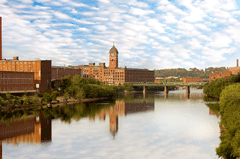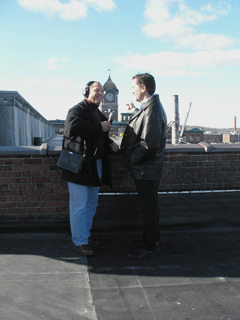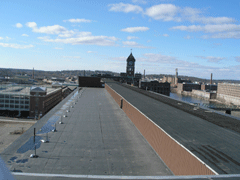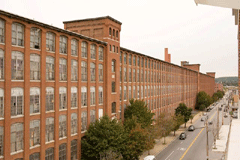Old Mill Gets Green Makeover
Air Date: Week of July 13, 2007

Lawrence, MA. (Photo: Massinnovation)
An historic, but rundown, mill in Lawrence, Massachusetts is being transformed into the nation's largest green redevelopment project. The famous Wood Mill, once the largest textile mill in the world, will be converted into condominiums that use geothermal heat. Living on Earth’s Bruce Gellerman reports on the mill, and on Lawrence, past, present and future.
Transcript
[MUSIC: WEST SIDE STORY: Debbie Gravitte “America (from ‘West Side Story’)” from ‘The Only Broadway CD You’ll Ever Need’ (BMG – 1995)]
CURWOOD: West Side story is a musical vision of immigrant America played out in New York City. But the vision was born, as was its composer, Leonard Bernstein just north of Boston in Lawrence, Massachusetts. Lawrence was the first stop on the way to the American dream for thousands of immigrants to the U.S., including Bernstein’s parents. The family was drawn from Russia by the boom created by the big textile mills of the first planned industrial city in America built on the banks of the Merrimack River. By the late 20th century, though the dream had died. The mills were mostly shuttered and Lawrence had become one of the poorest cities in the nation. But as Living on Earth’s Bruce Gellerman reports this relic of the industrial revolution is now trying to remake itself for a new century using green technology.
GELLERMAN: This is a tale of 3 cities: Lawrence, Massachusetts past, present, and future. You can see all three from the rooftop vantage point of an old mill building.
ANSIN: This is the challenging part of the tour.
GELLERMAN: Real estate developer Bob Ansin leads the way up a nearly vertical wood ladder to the top of the six story mill.
ANSIN: But I promise you it’s well worth the climb. And your reward.
[DOOR UNLOCKS]
ANSIN: My gosh, look at this.

Lawrence, MA. (Photo: Massinnovation)
A bald eagle soars overhead and a falcon swoops along the banks of the Merrimack River as it flows through Lawrence, East to the Atlantic.
ANSIN: They say in real estate, the three most important things are location, location, location. Show me a better location. I’ll tell you there aren’t any
GELLERMAN: The mighty Merrimack River is why the city’s founders chose this spot. They came to Lawrence to create an urban industrial city based on the latest technology.
The Great Stone Dam, constructed in 1847, harnessed the Merrimack - at the time it was the longest dam in the world. The water provided the energy to run more than 20 massive textile mills that rose along the river banks.
[CLOCK TOWER SOUNDS]
GELLERMAN: The clock tower atop Ayer Mill is still the largest of its kind in America, and right next door is the Wood Mill. When it was built in 1906 the huge red brick building was nicknamed: “the eighth wonder of the world” it was the largest textile plant on the planet. Four years ago developer Bob Ansin bought the old Wood Mill and renamed it: Monarch on the Merrimack.

Bruce Gellerman interviews Bob Ansin as they look out at the old clocktower. (Photo: Bruce Gellerman)
GELLERMAN: The old mill is 1600 feet long and contains one and a third million square feet. But except for some warehousing the place has been empty for years. The mill is run down. So is Lawrence. The unemployment rate is twice as high, and incomes, half the state average. The old Wood mill is a metaphor for the city.
ANSIN: When I started this business people would tell me, “What do you want with an obsolete white elephant in a city like Lawrence?” And my response is, the only thing obsolete is thinking the fact that we economically can’t make textiles here eliminates one use out of a million uses for a building such as this.
GELLERMAN: Ansin is turning the white elephant into a huge green energy project; morphing the mothballed Wood Mill into Monarch on the Merrimack. There’ll be 600 luxury condos, a jazz club, a restaurant - café, and retail shops. Around the construction site are signs that read: “Green People Wanted”

When the Wood Mill was built in 1906, it was hailed as 'the eighth wonder of the world.' At a third of a mile long and with almost 30 acres under one roof, it has been described as a horizontal skyscraper. (Photo: Bruce Gellerman)
GELLERMAN: To fulfill that vision and make it commercially viable to heat and cool the enormous mill building all factors pointed in one direction: straight down.
[DRILLING SOUNDS]
GELLERMAN: In the parking lot between the Merrimac River and the old Mill building workers drill into the earth.
BOVENZI: This right now, I believe is the largest, privately funded geothermal project in the United States.
GELLERMAN: Mathew Bovenzi is president of Commonwealth National Drilling, he and his workers are boring the first of 60 wells each 15 hundred feet deep into the granite below.
According to federal officials, a geothermal exchange system- like this one-is the most efficient and environmentally friendly way to heat and cool a building. Matt Bovenzi says it’s the best way on earth because it uses the earth. If you have ever walked into a cool basement on a hot day you know how geothermal exchange works.
BOVENZI: Essentially if you think of the ground as, the thermal mass is so large, it relatively stays at a constant temperature. At about five feet down, down to about 1500 feet you can expect the ground temperature to be 53-54 degrees Fahrenheit. So the idea is that if you take the heat load or the cooling load of the building and pump that into the ground, the ground’s temperature is going to stay constant so you can regulate the temperature of the building just by the temperature of the ground.
GELLERMAN: So what you do is, let’s say in the summer, you have hot water that comes out of the building, and it goes into the ground it comes out much cooler?
BOVENZI: Exactly. Essentially if the building is 80 degrees and you know the ground is 54, over time you just keep pumping the 80 degree temperature into the ground and then you bring the net difference of the cooling effect back into the building which will drop the building’s temperature.
GELLERMAN: And in the winter you reverse the process?
BOVENZI: Exactly
GELLERMAN: Monarch on the Merrimack’s geothermal exchange system is expected to save condo owners about 30 percent on their heating and cooling costs. The only fossil fuels used are to run the pumps and compressors. Bob Ansin says you’d have to plant a forest with 600 acres of trees to derive the same benefit to the environment as the Monarch on the Merrimack project will save in terms of global warming gases.

The ecoluxury lofts at Monarch were designed with sustainable development principles in mind - renewable resources (bamboo countertops, geothermal heating and cooling), reclaimed materials (reclaimed maple floors), and by hiring and purchasing locally, wherever possible.(Photo: Massinnovation)
ANSIN: Which will have trees and have plants and have grasses specially built to hold water as much as possible.
GELLERMAN: That will help prevent sewers on the ground from overflowing into the Merrimack River and keep the building cooler. But Ansin’s project isn’t just about protecting the environment for the future; it’s also about preserving the past. The mill building may be empty today but it’s filled with history.
JAYSANE: The wood mill was, for it’s time a very modern place.
GELLERMAN: Patricia Jaysane is executive director of the Lawrence History Center. She says the city lies at a critical junction in American industrial, cultural and technological history. It’s where the American labor movement was born.
[MUSIC: Bill Martin “The River Turns The Wheel” from ‘The River Turns The Wheel’ (Mill Rat Music – 1997)]
GELLERMAN: By the turn of the 20th century mill owners, who had started as urban idealists, had become cold-hearted industrialists.
Hundreds of thousands of workers came from Ireland and Italy, Eastern Europe and the Middle East to work the mills. Lawrence became known as Immigrant City a place of squalid tenements and horrendous factories.
JAYSANE: With all the mills you had the same kind of conditions. You had the machinery, which was incredibly loud.
[SOUND MILL WORKING]
GELLERMAN: Construction workers converting Wood Mill into Monarch on the Merrimack recently found these old recordings of mill workers and weaving machines.
WOMAN: The machine would start up and it might have a humming noise, hmmmmm. It wasn’t like the weaving room pickapickapicka oh my God.
[SOUND OF SEWING MACHINES]
GELLERMAN: 25 thousand people worked in the mills, most were women, many were children, some as young as seven years old.
JAYSANE: It was very dangerous work. Injury was very, very common as well as illness from the working conditions. The dust would just build up
GELLERMAN: A third of the workers died before they were 25. In the winter of 1912 a new Massachusetts law went into effect cutting the work week from 56 to 54 hours. Mill owners responded by speeding up the looms. The workers - 20 thousand strong - went on strike.
[MUSIC: I’M STICKING WITH THE UNION: Woody Guthrie (Composer) “I’m Sticking With The Union (Instrumental)” performed by unknown artist from ‘Lawrence, Mass. Music Library Archives’ (Source material reel-to-reel 1/4” tape – approx. 1941)]
GELLERMAN: The Lawrence Mill owners struck back with goon squads beating up workers. The National Guard was called in. For three months the workers held fast demanding bread, increased wages, and roses: respect.
[MUSIC: Judy Collins “Bread And Roses” from ‘Forever: The Judy Collins Anthology’ (Elektra/Asylum – 1970)]
GELLERMAN: The Bread and Roses strike was a turning point in the American labor movement and the Wood Mill was at its epicenter. Developer Bob Ansin:
ANSIN: 90 odd years ago had we been in this spot, in this mill, on this floor you would be seeing workers sabotaging their machines, you’d be seeing people from 50 countries, speaking 50 languages, marching along this hall way, convincing their fellow workers to also join the strike, as well they did.
GELLERMAN: In the end the mill owners met the workers’ demands.
[BELLS FROM AYER MILL CLOCK TOWER]
GELLERMAN: But at the end of World War Two textile manufacturers pulled the plug on Lawrence’s mills moving machinery and jobs to the south, then overseas, draining the lifeblood out of the city.
For a while main frame computers were manufactured in Wood mill. Then that technology became obsolete too and companies again left Lawrence. Unemployment soared. In the 1990’s the city became known as the arson capitol of the country. Lawrence was dying.
That’s the situation developer Bob Ansin found when he arrived with his plan to turn historic Wood Mill into Monarch on the Merrimack, mindful of the past but with one eye on the future and the other on the bottom line.

Bob Ansin, president of Massinnovation and developer of Monarch on the Merrimack. (Photo: Bruce Gellerman)
ANSIN: I didn’t become a green developer through being an environmentalist. It’s less risky and more profitable to use green technologies. I see this as smart business.
GELLERMAN: It’s a double green bottom line, part of a growing trend says housing consultant Ed Connelly.
CONNELLY: What I see, is I think the financing side is starting to drive it.
GELLERMAN: Connelly is president of New Ecology. His firm helps developers design and build green affordable housing projects. He says in recent years there’s been a fundamental shift among large financial companies interested in backing geothermal and other renewable energy projects.
CONNELLY: So it’s a very big change. I’ve been doing this for 10-15 years and 15 years ago, if you talked to corporate about this and they looked at you as a crazy tree hugger. And now that’s changing.
GELLERMAN: Connelly says, Monarch on the Merrimack is such a big geothermal project that if it’s successful it’s bound to have a huge economic impact on Lawrence, Massachusetts and serve as a model for other project. Still that’s a big “if”.
CONNELLY: In real estate market, I mean, obviously it’s still very complex. Location, location, location is still the mantra, that people are not going to go out of the way to buy a green building. At least most people won’t, but I think that in an increasingly competitive marketplace, that this is going to be one of the distinguishing characteristics of buildings.
GELLERMAN: That’s what developer Bob Ansin is banking on. His Monarch on the Merrimack project is a 200 million dollar bet that by restoring one old mill building in Lawrence using green technology he can help revitalize a city where hopes and fortunes once soared.
[MUSIC: Bill Martin “The River Turns The Wheel” from ‘The River Turns the Wheel’ (Mill Rat Music – 1997)]
ANSIN: We came to Lawrence with a vision for how to bring a place that was built for one economic reality, how to bring it back for today’s economic reality and do it in a way so that my kids and their kid’s kids will never find themselves in a position to have to say, gee too bad it wasn’t built sustainably.

Monarch on the Merrimac, Lawrence, MA. (Photo: Massinnovation)
For Living on Earth I’m Bruce Gellerman
[MUSIC Bill Martin “The River Turns The Wheel” from ‘The River Turns the Wheel’ (Mill Rat Music – 1997)]
Links
Living on Earth wants to hear from you!
Living on Earth
62 Calef Highway, Suite 212
Lee, NH 03861
Telephone: 617-287-4121
E-mail: comments@loe.org
Newsletter [Click here]
Donate to Living on Earth!
Living on Earth is an independent media program and relies entirely on contributions from listeners and institutions supporting public service. Please donate now to preserve an independent environmental voice.
NewsletterLiving on Earth offers a weekly delivery of the show's rundown to your mailbox. Sign up for our newsletter today!
 Sailors For The Sea: Be the change you want to sea.
Sailors For The Sea: Be the change you want to sea.
 The Grantham Foundation for the Protection of the Environment: Committed to protecting and improving the health of the global environment.
The Grantham Foundation for the Protection of the Environment: Committed to protecting and improving the health of the global environment.
 Contribute to Living on Earth and receive, as our gift to you, an archival print of one of Mark Seth Lender's extraordinary wildlife photographs. Follow the link to see Mark's current collection of photographs.
Contribute to Living on Earth and receive, as our gift to you, an archival print of one of Mark Seth Lender's extraordinary wildlife photographs. Follow the link to see Mark's current collection of photographs.
 Buy a signed copy of Mark Seth Lender's book Smeagull the Seagull & support Living on Earth
Buy a signed copy of Mark Seth Lender's book Smeagull the Seagull & support Living on Earth

